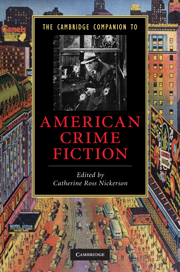Book contents
- Frontmatter
- 1 Introduction: The satisfactions of murder
- 2 Early American crime writing
- 3 Poe and the origins of detective fiction
- 4 Women writers before 1960
- 5 The hard-boiled novel
- 6 The American roman noir
- 7 Teenage detectives and teenage delinquents
- 8 American spy fiction
- 9 The police procedural in literature and on television
- 10 Mafia stories and the American gangster
- 11 True crime
- 12 Race and American crime fiction
- 13 Feminist crime fiction
- 14 Crime in postmodernist fiction
- Guide to reading
- Index
9 - The police procedural in literature and on television
Published online by Cambridge University Press: 28 September 2010
- Frontmatter
- 1 Introduction: The satisfactions of murder
- 2 Early American crime writing
- 3 Poe and the origins of detective fiction
- 4 Women writers before 1960
- 5 The hard-boiled novel
- 6 The American roman noir
- 7 Teenage detectives and teenage delinquents
- 8 American spy fiction
- 9 The police procedural in literature and on television
- 10 Mafia stories and the American gangster
- 11 True crime
- 12 Race and American crime fiction
- 13 Feminist crime fiction
- 14 Crime in postmodernist fiction
- Guide to reading
- Index
Summary
“Presence” is an important concept in contemporary urban law enforcement practice. Since the late 1960s, evolving strategies and practices in police departments the world over have emphasized the benefits of increased police presence - putting more officers on the streets, increasing the frequency of car patrols, and so forth. Making the police more present, in practical terms, means making them more visible, the assumption being that the spectacle of police power makes easier and more effective the exercise of that power. In fact, this is not so new a concept. From the beginning, police were meant to have presence. When in 1829 Sir Robert Peel replaced the archaic Watch with London's Metropolitan Police Force, generally considered the first urban institution worthy of the name, he dressed his men to impress. The sight of a tall-bonneted, bright-buttoned “bobby” presumably being more likely to give a malfeasant pause for thought than that of a Watchman looking like every other lad down the pub.
Uniformed police, marked by that garb as privileged members of a government-sanctioned, paramilitary organization with broad discretionary powers, function today as in Peel's time as walking deterrents, visible signs of state power and surveillance. As such, urban police forces have in recent years deployed their officers not so much according to an individual's expertise or affinity with specific neighborhoods and communities, but in response to statistical mappings of criminal behavior, assigning more personnel to areas where the threat to people and to property is perceived to be greatest. Ironically, then, seeing more cops frequently means an area is more dangerous, not less. If assessed by that metric, current popular culture is a mighty perilous place. However fortunately far one might be from the grim realities of urban crime, however mercifully infrequent one’s personal encounters with police in their professional capacity might be, we are never more than a click away from cops.
- Type
- Chapter
- Information
- The Cambridge Companion to American Crime Fiction , pp. 96 - 109Publisher: Cambridge University PressPrint publication year: 2010
- 3
- Cited by



